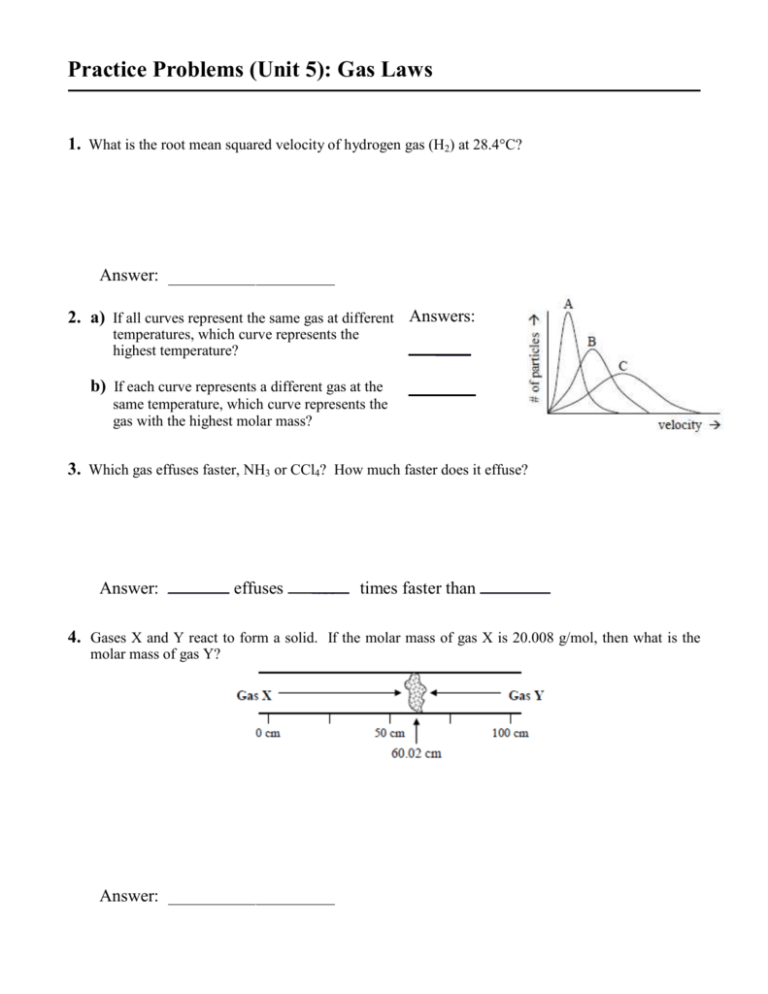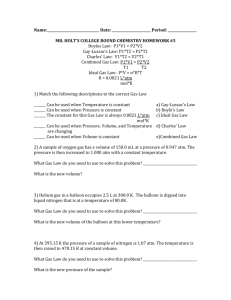File
advertisement

Practice Problems (Unit 5): Gas Laws 1. What is the root mean squared velocity of hydrogen gas (H2) at 28.4°C? Answer: 2. a) If all curves represent the same gas at different Answers: temperatures, which curve represents the highest temperature? ____ b) If each curve represents a different gas at the same temperature, which curve represents the gas with the highest molar mass? 3. Which gas effuses faster, NH3 or CCl4? How much faster does it effuse? Answer: _______ effuses _____ times faster than ________ 4. Gases X and Y react to form a solid. If the molar mass of gas X is 20.008 g/mol, then what is the molar mass of gas Y? Answer: 5. A large balloon filled with helium gas (occupying 293.1 L at 24.8ºC and 769.2 torr) is released. What volume (in L) would the balloon occupy when it reaches an altitude where the conditions are –18.7ºC and 383.6 torr? Answer: 6. A gas in a 975 mL cylinder is at 835 torr. If the gas is compressed by a piston to 225 mL, what is the pressure of the gas (in atm)? Answer: 7. Hydrogen gas is collected over water at 27.0ºC and 748.9 torr. If 3.978 L of gas is collected, how many moles of hydrogen are in the container? (PH2O = 26.5 torr at 27.0ºC) Answer: ______________ 8. If 0.598 mol N2, 0.153 mol O2, and 0.079 mol CO2 are exhaled into a balloon, what volume would the balloon occupy at STP? Answer: 9. 32.42 mol Gas A, 28.15 mol Gas B, and 19.69 mol Gas C are in a 1799 L chamber at STP. What is the partial pressure of Gas B (in atm)? Answer: 10. How many liters of CO2 (at STP) are produced when 250. g of octane (C8H18) are combusted according to the following equation? 2 C8H18 (l) + 25 O2 (g) 16 CO2 (g) + 18 H2O (g) 250. g Answer: 11. Ammonia (NH3) is produced industrially at high temperatures and pressures. What is the density of ammonia gas at 550.°C and 245 atm? Answer: 12. Using the van der Waals equation, calculate the observed pressure of 25.85 moles of xenon gas in a 150.0 L chamber at –25.0°C (a = 4.19 atm·L2/mol2, b = 0.0511 L/mol). Answer: Questions 13-14 refer to the following pure substances, which are gases at 25°C and 1 atmosphere. (A) NH3(g) (B) BH3(g) (C) H2(g) (D) CH4 (g) (E) HBr(g) 18. Under which of the following conditions of temperature and pressure would 1.0 mol of the real gas CO 2(g) behave most like an ideal gas? Temperature Pressure (K) (atm) (A) 100 0.1 (B) 100 100 (C) 800 10 (D) 800 0.1 (E) 800 100 13. Is a strong electrolyte in aqueous solution. 14. Is the slowest to effuse through a small opening at 25°C and 1 atmosphere. 15. According to the equation below, how many moles of potassium chlorate, KClO3, must be decomposed to generate 1.0 L of O2 gas at standard temperature and pressure? 2 2 KCl(s) + 3 O2(g) 2KClO3(s) MnO 1 1 mol 3 22.4 2 1 (C) mol 3 22.4 (A) 1 1 mol 2 22.4 3 1 (D) mol 2 22.4 (B) 1 mol 22.4 (E) 2 16. The pressure, in atm, exerted by 1.85 mol of an ideal gas placed in a 3.00 L container at 35°C is given by which of the following expressions? (A) (B) 1.850.0821308 atm 3.00 1.8535.0 atm 3.000.0821 3.00 atm 1.850.0821308 1.858.314308 atm (D) 3.00 3.001.85 atm (E) 0.082135.0 (C) 17. Equal masses of He and Ne are placed in a sealed container. What is the partial pressure of He if the total pressure in the container is 6 atm? (A) 1 atm (B) 2 atm (C) 3 atm (D) 4 atm (E) 5 atm 19. At standard temperature and pressure, a 0.50 mol sample of H2 gas and a separate 1.0 mol sample of O2 gas have the same (A) average molecular kinetic energy (B) average molecular speed (C) volume (D) effusion rate (E) density Questions 20-22 refer to the following gases at 0 C and 1 atm. A. Ne B. Xe C. O2 D. CO E. NO 20. Has an average atomic or molecular speed closest to that of N 2 Molecules at 0 C and 1 atm. 21. Has the greatest density. 22. Has the greatest rate of effusion through a pinhole. 23. A flask contains 0.25 mole of SO2(g), 0.50 mole of CH4(g), and 0.50 mole of O2(g). The total pressure of the gases in the flask is 800 mm Hg. What is the partial pressure of the SO 2(g) in the flask? A. 800 mm Hg B. 600 mm Hg C. 250 mm Hg D. 200 mm Hg E. 160 mm Hg 24. What volume of O2(g) is required to react with excess CS2(l) to produce 4.0 L of CO2(g)? (Assume all gases are measured at 0oC and 1 atm.) A. 12 L B. 22.4 L C. 1/3 x 22.4 L D. 2 x 22.4 L E. 3 x 22.4 L 25. An excess of Mg(s) is added to 100. mL of 0.400 M HCl. At 0oC and 1 atm pressure, what volume of H2 gas can be obtained? A. 22.4 mL B. 44.8 mL C. 224 mL D. 448 mL E. 896 mL 26. A 2 L container will hold about 4 g of which of the following gases at 0C and 1 atm? A. SO2 B. N2 C. CO2 D. C4H8 E. NH3 NH4NO3 (s) 30. A 0.03 mol sample of NH4NO3 is placed in a 11 L evacuated flask which is then sealed and heated. The NH4NO3 decomposes completely according to the equation above. The total pressure of the flask at 400K would be closest to which of the following? A. 3 atm 27. A hot-air balloon rises. Which of the following is the best explanation for this observation? A. The pressure on the walls of the balloon increases with increasing temperature. B. The difference in temperatures between the air inside and outside the balloon produces convection currents. C. The cooler air outside of the balloon pushes on the walls of the balloon. D. The rate of diffusion of cooler air is less than warmer air. E. The air density inside the balloon is less than the surrounding air. 28. A rigid metal tank contains oxygen gas. Which of the following applies to the gas in the tank when additional oxygen is added at constant temperature. A. The volume of the gas increase B. The pressure of the gas decreases C. The average speed of the gas molecules remains the same D. The total number of moles of gas remains the same E. The average distance between the gas molecules increases W(g) + X(g) Y(g) + Z(g) 29. Gases W and X react in a closed, rigid vessel to form gases Y and Z according to the equation above. The initial pressure of W(g) is 1.20 atm and that of X(g) is 1.60 atm. No Y(g) or Z(g) is initially present. The experiment is carried out at constant temperature. What is the partial pressure of Z(g) when the partial pressure of W(g) has decreased to 1.0 atm? A. B. C. D. E. 0.20 atm 0.40 atm 1.0 atm 1.2 atm 1.4 atm N2O (g) + 2H2O(g) B. 1 atm C. 0.5 atm D. 0.1 atm E. 0.03atm









